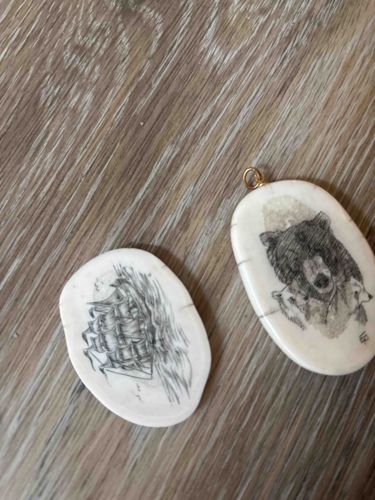
Alaskan Native Hand-Carved Ivory Scrimshaw Pendants
This item consists of two distinct, hand-carved ivory pendants, likely originating from Alaskan Native artistry, as suggested by the provided context. Each pendant is unique in shape, though both are generally ovoid or shield-shaped with smooth, polished surfaces and slightly irregular edges, indicating their organic origin and hand-finishing. The material appears to be aged ivory, exhibiting a creamy white to very light yellow coloration consistent with natural aging and patination. Fine, dark stress lines or natural growth lines are visible on both pieces, particularly on the larger pendant, adding to the authenticity and character of the material. The artistic technique applied to both pendants is scrimshaw, where detailed images are etched or incised into the ivory surface and then typically filled with pigment to make the design stand out. The larger pendant, which features a brass or gold-tone jump ring for suspension, depicts a bear (possibly a grizzly or brown bear) with discernible facial features, possibly accompanied by or observing smaller creatures or pups, although the finer details are somewhat obscured by the image resolution. The bear's fur is rendered with fine, short lines, giving a textured appearance. The background seems to incorporate faint, naturalistic elements. The overall execution suggests a skilled hand. The smaller pendant portrays a stylized sailing ship with multiple masts and sails, set against what appears to be abstract waves or a symbolic representation of water or flowing elements, possibly hair or wind. The ship is rendered with strong lines and a sense of movement. Both pieces appear to be in good overall condition, with no overt signs of significant damage such as chips or cracks beyond the natural lines inherent to the ivory. The craftsmanship indicates a high level of artistic skill and attention to detail, typical of traditional Alaskan Native scrimshaw art. Given the nature of ivory and the likely cultural context, these pieces could date from the mid-20th century to more contemporary periods, reflecting a continuation of traditional art forms.
AI-Generated Appraisal Disclaimer
Estimated Value
$250-500
Basic Information
Category
Jewelry/Art Collectibles
Appraised On
December 2, 2025
Estimated Value
$250-500
Additional Details Provided By Owner
User Provided Information
Alaskan native Art hand carved ivory
Item Description
This item consists of two distinct, hand-carved ivory pendants, likely originating from Alaskan Native artistry, as suggested by the provided context. Each pendant is unique in shape, though both are generally ovoid or shield-shaped with smooth, polished surfaces and slightly irregular edges, indicating their organic origin and hand-finishing. The material appears to be aged ivory, exhibiting a creamy white to very light yellow coloration consistent with natural aging and patination. Fine, dark stress lines or natural growth lines are visible on both pieces, particularly on the larger pendant, adding to the authenticity and character of the material. The artistic technique applied to both pendants is scrimshaw, where detailed images are etched or incised into the ivory surface and then typically filled with pigment to make the design stand out. The larger pendant, which features a brass or gold-tone jump ring for suspension, depicts a bear (possibly a grizzly or brown bear) with discernible facial features, possibly accompanied by or observing smaller creatures or pups, although the finer details are somewhat obscured by the image resolution. The bear's fur is rendered with fine, short lines, giving a textured appearance. The background seems to incorporate faint, naturalistic elements. The overall execution suggests a skilled hand. The smaller pendant portrays a stylized sailing ship with multiple masts and sails, set against what appears to be abstract waves or a symbolic representation of water or flowing elements, possibly hair or wind. The ship is rendered with strong lines and a sense of movement. Both pieces appear to be in good overall condition, with no overt signs of significant damage such as chips or cracks beyond the natural lines inherent to the ivory. The craftsmanship indicates a high level of artistic skill and attention to detail, typical of traditional Alaskan Native scrimshaw art. Given the nature of ivory and the likely cultural context, these pieces could date from the mid-20th century to more contemporary periods, reflecting a continuation of traditional art forms.
Get Your Items Appraised
Instant estimates of your treasures with AI-powered instant appraisals